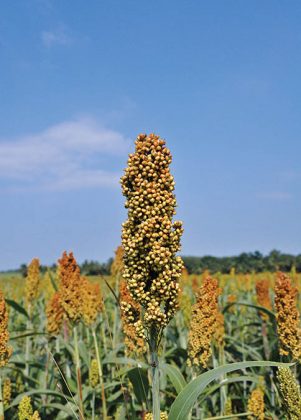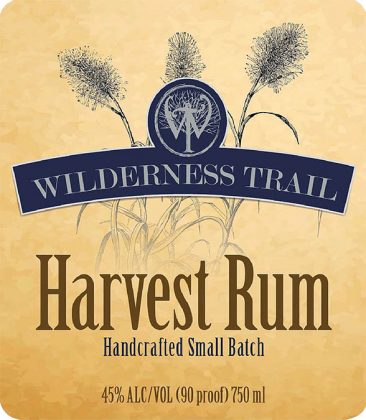Sorghum spirits are the shape-shifters of the distilling world. In the liquor aisle you can find sorghum rum, sorghum whiskey, and products labeled simply as “sorghum spirits.” Sorghum appears to be neither fish nor fowl, but some miracle plant from which a variety of liquors are produced. It brings to mind Homer Simpson’s disbelief in a “wonderful, magical animal” from which we get ham, bacon and pork.
So what is sorghum, and, more importantly, what can distillers make from it?
Let’s start with a little background: Sorghum is typically classified as a cereal grain. It’s a leafy grass that, depending on variety, can grow six to eight feet or more. From a distance, a sorghum field can look like sugar cane or corn; up close the plants have berrylike clusters sprouting atop each head. The plant is native to Africa, and came to the United States (likely via the slave trade) in the early 17th century. Colonists found that it grew with admirable abandon in the summer heat—while proving to be both more flood- and drought-resistant—and could grow in more temperate climates than sugar cane. And so it became a popular crop in the Upper South and Midwest; today, Kentucky and Tennessee are the nation’s leading growers.
Although sorghum bears grains like wheat and corn, it’s typically processed differently—harvested and then crushed through rollers like sugar cane, producing a syrup that is boiled down to a thick sweetener, often called sorghum molasses. (It’s widely used as an industrial sweetener today, and also as a source of fuel ethanol.)
Sorghum’s appeal to beverage distillers is not new. It was pressed into service during the Civil War to make spirits when blockades disrupted the southern booze trade, then again during Prohibition when revenuers started meddling with traditional production. “It grew more quickly and was less trouble than corn,” writes Ronni Lundy in her book Sorghum’s Savor. “A distiller could grow his own sweetening without calling much attention as buying big bags of sugar at the store surely would.”
Phil Prichard, who launched Prichard’s Rum in 1997, liked the taste of his experimental liquor made from sorghum. His original plan was to make a rum from it, and he was on the verge of having the TTB sign his paperwork when the agent arched an eyebrow. “All of a sudden he’s reading what I’m making and he says, ‘Phil, I’m not sure you can make rum from sorghum molasses,’” Prichard recalls. “Federal regulators describe rum as being made from product of the sugar cane.”
Prichard rang up researchers at the University of Tennessee, who assured him the glucose molecule of sorghum molasses was identical to a sugar cane molecule, and an argument could be made. But Prichard foresaw a long and possibly fruitless debate with TTB; even if successful, his launch would be delayed. So he switched up his plans and trucked Louisiana sugar cane molasses to Tennessee. “If I were starting over again and had Internet and Wikipedia, I might have done it differently,” he says, believing he could have made the case to the TTB.
Among those who did do it differently were Shane Baker and Pat Heist, founders of Wilderness Trail Distillery in Kentucky. They were approached by Danny Townshend, a third-generation sorghum grower, who gave the distillers some sorghum molasses to run through their still. They liked what resulted. They created a label calling it Harvest Rum, and submitted it for federal approval.
“They rejected it,” says Jared Smith, a spokesperson for the distillery, which also makes vodka, wheated whiskey, rye and bourbon. “So we sent a lot of technical data and historical data about similarities both genetically and historically between sorghum and cane molasses,” Smith says.
Their persistence paid off. The TTB eventually signed off on the label, which also features, in smaller type, the composition statement, “Handmade from Kentucky Sorghum Molasses.”
“We’ve had people call us wanting to know who we bribed, or how we got that passed,” Smith says. “I’m going to be intentionally vague because I don’t want to piss off the government, but we are truthfully, legally and thoughtfully able to say we make rum by definition now.”
Does that mean other distillers will get TTB approvals if they submit their sorghum spirits as a rum?
Unlikely.
“There’s a standard of identity for rum, and sorghum will not get you there,” says Tom Hogue, congressional and public affairs director at TTB. He notes that rum is defined as “spirits distilled from the fermented juice of sugar cane, sugar cane syrup, sugar cane molasses or other sugar cane by-products… [and] having the taste, aroma and characteristics generally attributed to rum.”
As to how Harvest Rum came to be labeled as rum, Hogue declined to comment, as department policy forbids him from discussing specific products. “If we issue a label that is in error, calling a product something that it shouldn’t be, that’s something we have to take up with that label,” he says.
(Labeling sorghum spirits as whiskey—as several producers do—also raises a host of questions, since few distillers use the actual grains from the head of the plant. It’s produced the same way as “rum” is made—the stem is crushed and the naturally sweet juice is fermented—raising the question of whether this is truly “distilled from a fermented mash of grain,” as the TTB defines whiskey. But that’s another debate.)
Several other distillers making spirits from sorghum have had labels approved as rum, although likewise with additional composition statements. Pecan Street Rum (made by Spirit of Texas) includes the label statement “Distilled Spirits Specialty,” and Carl’s Carolina Original Spiced Sorghum Rum (made by Petzold Distilleries in North Carolina) adds “Spirits Distilled from Sorghum with Cinnamon.”
A number of producers have produced “sorghum whiskey”—including Wisconsin’s Old Sugar Distillery and StilL 630 in St. Louis. Scott Blackwell of High Wire Distilling in South Carolina also produces a whiskey from sorghum. He believes most sorghum whiskey is made of molasses from the juices of the crushed stalk; he sources his from a Mennonite farm in Tennessee, where the whole plant is crushed, head and all. Blackwell says it produces a “buckwheaty flavor profile” that’s “much more wild tasting.” Getting label approval for this was one of the more complicated processes, he says. “We explained the whole thing, and the TTB went back to the specialists and then said you’re going to need to put that in new barrels and you’re going to need to call that whiskey.” Which is what he does. TTB requires that labels for products
falling outside the traditional categories must display a brand name—“a fanciful name”—and a statement of composition. “We want it labeled in such a way so the consumer knows what they’re getting,” says TTB’s Hogue.
But some industry observers question whether that’s truly happening, even with the additional statement of composition, if “rum” can be included in the brand or fanciful name.
“To me it degrades the category of rum, and the category of rum is degraded enough,” says Ed Hamilton, importer of rhum agricoles and his own Hamilton Pot Stilled Rum. “We don’t need more exceptions to the rule. It’s part of the reason why rum isn’t taking off.”
Longtime rum consultant Luis Ayala adds that playing loose with categories could come back to bite the industry as craft spirits enter overseas markets, most of which also define rum as being made only from sugar cane. “When they see that in the U.S. there are products being sold as rum made with non-sugar cane products, it speaks badly of our ability to enforce our own code,” he says. “And by association the entire craft movement inherits some of that lack of regard for the laws.”
Ayala hopes that producers will become more assertive in policing their own industry, and enforcing more clearly demarcated fences between spirit categories. “The producers of sorghum [spirits] should come up with their own category,” he suggests, “and not try to disguise themselves as something else.”










